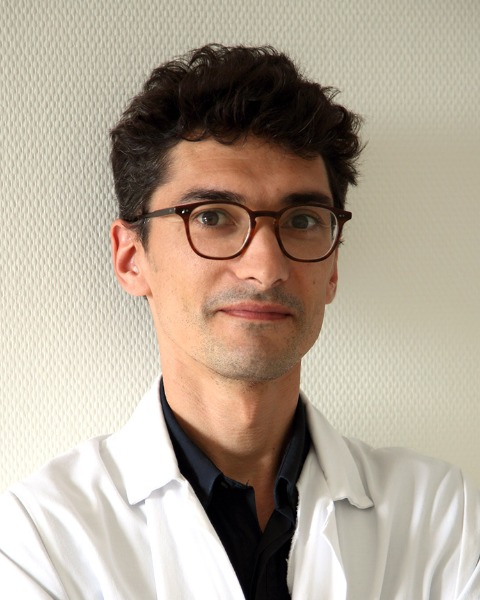Oral Abstract Session
OA-54: Daratumumab, Carfilzomib, Lenalidomide, and Dexamethasone with tandem transplant in high-risk newly diagnosed myeloma patients: final results of the phase 2 study IFM 2018-04
Thursday, September 28, 2023
6:03 PM - 6:15 PM EEST
Location: Skalkotas

Cyrille Touzeau, MD, PhD
Hematologist
CHU Nantes
Nantes, France
Speaker(s)
Introduction: High-risk (HR) cytogenetics are associated with poor outcomes in transplant eligible (TE) newly diagnosed multiple myeloma (NDMM). The triplet combination carfilzomib, lenalidomide, and dexamethasone (KRd) plus transplantation demonstrated high efficacy with favorable safety profile in TE-NDMM patients (FORTE). The addition of daratumumab (Dara) to frontline therapy also improved response rates and progression free-survival in TE-NDMM patients (CASSIOPEIA, GRIFFIN). Double transplant has also improved outcome of HR TE NDMM patients (EMN02). The phase 2 trial 2018-04 from the Intergroupe Francophone du Myelome (IFM) evaluated feasibility of an intensive strategy with Dara-KRd induction and consolidation plus double transplant in HR TE NDMM (NCT03606577).
Methods: HR MM was defined by the presence of del17p, t(4;14) and/or t(14;16). Treatment strategy included Dara-KRd induction (6 cycles), autologous stem cell transplantation (ASCT), Dara-KRd consolidation (4 cycles), second ASCT, and Dara-lenalidomide maintenance for 2 years. The primary endpoint was the feasibility of this intensive strategy.
Results: Fifty patients with previously untreated NDMM were included from July 2019 to March 2021 in 11 IFM centers. Median age was 57 (range 38 -65). Based on inclusion criteria, all patients had HR cytogenetics, including 17p deletion (n=20, 40%), t(4;14) (n=26, 52%) or t(14;16) (n=10, 20%). Four (8%) patients had extramedullary disease. At data cut-off, the study met the primary endpoint with 36 (72%) patients completing second transplant. Twenty patients (40%) discontinued the study, due to stem-cell collection failure (n=8), disease progression (n=7), adverse event (n=4), consent withdrawal (n=1). Grade 3-4 Dara-KRd induction/consolidation related adverse events (>5% of patients) were neutropenia (39%), anemia (12%), thrombocytopenia (7%) and infection (6%). Four patients discontinued treatment due to severe adverse events (COVID-19 infection, drug-induced hepatitis, JC virus related encephalopathy, intracerebral hemorrhage). Seven patients died; 5 due to disease progression and 2 due to infection. Responses deepened over time with an overall response rate for patients completing second transplant of 100%, including 81% complete response. Among evaluable patients (33/36), pre maintenance Minimal Residual Disease negativity rate (NGS, 10-6) was 94%. After a median follow up of 32 months, the 24-month PFS rate is 87% (78-87%) and the 24-month OS rate is 94% (87-100%).
Conclusions: Dara-KRd induction/consolidation with tandem transplant was feasible in TE NDMM patients with high-risk cytogenetic profile, and resulted in high rates of MRD negativity and PFS.
Methods: HR MM was defined by the presence of del17p, t(4;14) and/or t(14;16). Treatment strategy included Dara-KRd induction (6 cycles), autologous stem cell transplantation (ASCT), Dara-KRd consolidation (4 cycles), second ASCT, and Dara-lenalidomide maintenance for 2 years. The primary endpoint was the feasibility of this intensive strategy.
Results: Fifty patients with previously untreated NDMM were included from July 2019 to March 2021 in 11 IFM centers. Median age was 57 (range 38 -65). Based on inclusion criteria, all patients had HR cytogenetics, including 17p deletion (n=20, 40%), t(4;14) (n=26, 52%) or t(14;16) (n=10, 20%). Four (8%) patients had extramedullary disease. At data cut-off, the study met the primary endpoint with 36 (72%) patients completing second transplant. Twenty patients (40%) discontinued the study, due to stem-cell collection failure (n=8), disease progression (n=7), adverse event (n=4), consent withdrawal (n=1). Grade 3-4 Dara-KRd induction/consolidation related adverse events (>5% of patients) were neutropenia (39%), anemia (12%), thrombocytopenia (7%) and infection (6%). Four patients discontinued treatment due to severe adverse events (COVID-19 infection, drug-induced hepatitis, JC virus related encephalopathy, intracerebral hemorrhage). Seven patients died; 5 due to disease progression and 2 due to infection. Responses deepened over time with an overall response rate for patients completing second transplant of 100%, including 81% complete response. Among evaluable patients (33/36), pre maintenance Minimal Residual Disease negativity rate (NGS, 10-6) was 94%. After a median follow up of 32 months, the 24-month PFS rate is 87% (78-87%) and the 24-month OS rate is 94% (87-100%).
Conclusions: Dara-KRd induction/consolidation with tandem transplant was feasible in TE NDMM patients with high-risk cytogenetic profile, and resulted in high rates of MRD negativity and PFS.
